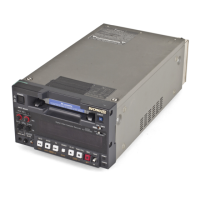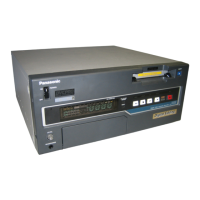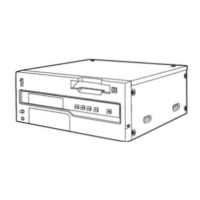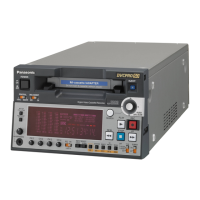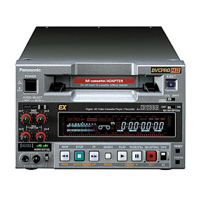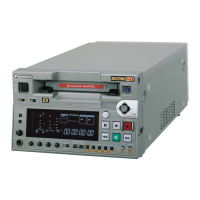Do you have a question about the Panasonic AJ-D230H and is the answer not in the manual?
Overview of the AJ-D230H digital video cassette recorder and its capabilities.
Detailed explanation of buttons, lamps, and indicators on the front panel.
Description of input and output connectors located on the rear panel.
Information on consumer-use, M size, and L size cassettes, and usage precautions.
Steps to power on the unit and insert a cassette tape correctly.
How to enter and exit the stop mode, and tape protection features.
Step-by-step guide for recording video and audio signals.
How to play back recorded tapes, including pause, still, cue, and review.
Setting the begin and end points for repeat playback mode.
Configuration of different repeat playback modes (OFF, MEM STOP, REPEAT 1, CONTINUE).
Explanation of the time code signal and its display format.
Details on the 32-bit user's bit for recording operator information.
Procedures for setting the time code and user's bit values using the menu.
How to display and interpret time code and user's bit during playback.
Explanation of abbreviations and character types for on-screen displays.
Customizing the position of superimposed displays and showing the VTR operating mode.
Step-by-step process for changing VTR settings using the menu system.
Procedure to reset all settings to factory defaults using the RESET button.
Setting what is displayed on the monitor output connector (time, mode, or none).
Adjusting horizontal/vertical position and type of superimposed characters.
Enabling or disabling menu setting changes to prevent accidental modification.
Configuring remote control access and tape timer display settings.
Settings for EE/VV output, wide mode, and tape end behavior.
Servo synchronization and automatic tape back-space settings.
Selecting recording format and enabling/disabling recording.
Setting baud rate, data length, stop bits, and parity for RS-232C.
Setting memory operation for repeat playback (OFF, MEM STOP, REPEAT 1, CONTINUE).
Configuring tape protection based on inactivity time (STILL TIMER) and mode (SRC PROTECT, STOP PROTECT).
Configuring VITC signal insertion, blanking, and regeneration settings.
Settings for user's bit format, CF flag, drop frame mode, and TC mode.
Setting the initial values for the time code generator and user's bit.
Settings for video mode (color/mono), mute, and closed capture signal blanking.
Configuring video processing and freeze mode selection for still pictures.
Enabling or disabling cue audio signals during search or fast playback.
Controlling audio output level during DV format playback.
Muting sound at back-space assemble points and selecting audio processing (cut/fade).
List of basic VTR functions controllable via RS-232C interface.
Checking the current VTR mode through RS-232C communication.
Detailed pin assignments and signal descriptions for the D-SUB connector.
Diagram showing typical wiring connections between a PC and the VTR.
Specifies baud rate, bit length, stop bit, and parity for RS-232C communication.
Defines communication system, baud rate, bit length, stop bit, and parity options.
Format for sending commands and data from a personal computer to the VTR.
Format for receiving acknowledgments and data from the VTR to a PC.
List of commands for controlling VTR operations like stop, eject, play, and record.
Command to inquire about the VTR's current operation mode.
Inquiring about current counter values (CTL, TCR) and their format.
Commands to set the VTR to standby ON or OFF modes.
Command to inquire about the TV system accommodated by the VTR.
List of error numbers displayed on the tape counter and their meanings.
Procedures for cleaning video heads and checking the hour meter.
Guidelines for condensation and general cabinet cleaning.
Power, dimensions, weight, recording format, video bandwidth, and input/output details.
Audio sampling frequency, dynamic range, connector types, and interface details.
Information regarding the display tube's counter and indicators.
| Recording Format | DVCPRO |
|---|---|
| Number of Audio Channels | 4 |
| Time Code | LTC, VITC |
| Playback Format | DVCPRO |
| Audio Recording Format | 16-bit PCM |
| Video Input | Composite, Y/C, Component |
| Audio Input | XLR |
| Video Output | Composite, Y/C, Component |
| Audio Output | XLR, RCA |
| Control Interface | RS-422 |
| Tape Speed | 33.8 mm/s (DVCPRO) |

